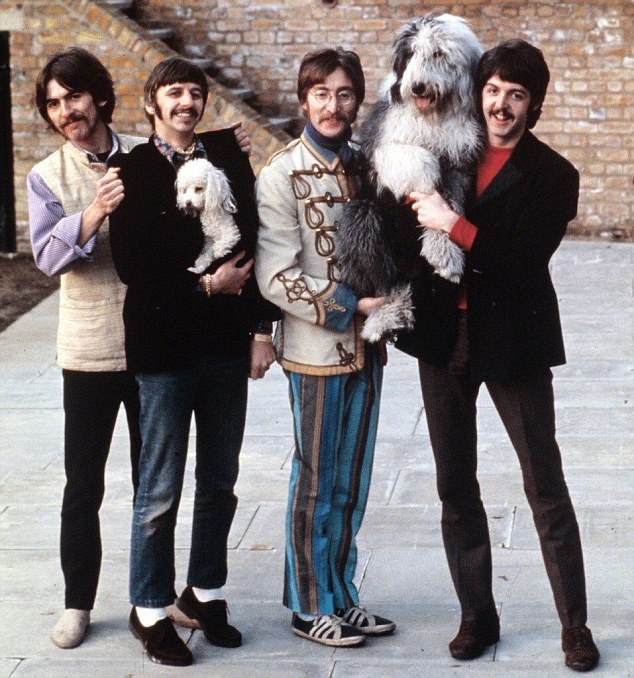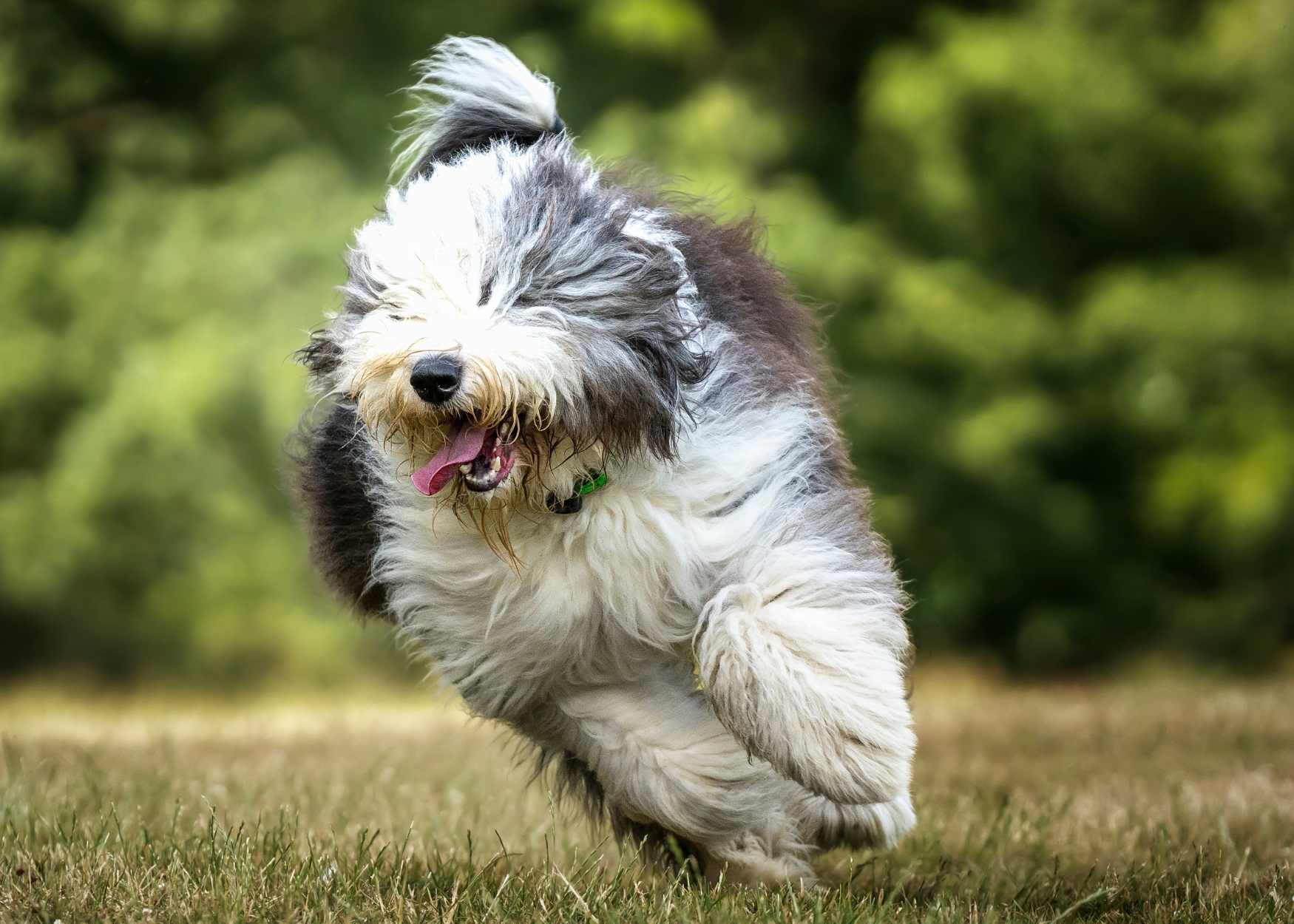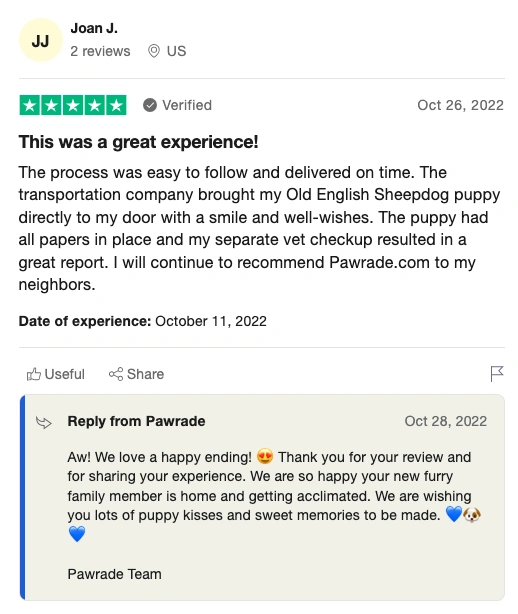Old English Sheepdogs are among one of the most recognizable dog breeds in the world thanks to their bear-like, lumbering gait, and shaggy peekaboo fur covering their faces except for a pink tongue and cute button nose. However, there's so much more to this breed than just their distinctive looks. Old English Sheepdogs are renowned for their intelligence, loyalty, and gentle nature. Used primarily as a herding dog in the 1800s in England, Old English Sheepdogs have always been hard-working, gentle, friendly dogs. Their exuberance for life makes them wonderful dogs for people who have the time to dote on the breed. They excel as family pets, forming strong bonds with their human companions and often taking on the role of devoted protectors.
Old English Sheepdogs are also known as OES and Bobtails. From their origins and historical significance to their unique personality traits and care requirements, learn about the Old English Sheepdog breed to see if this dog is right for you and your family.
Slumber, the 1914 Westminster Kennel Club winner
The Origin and History of Old English Sheepdogs
You may assume Old English Sheepdogs originated in England because of their name, but the truth of the breed’s origin is a bit murky. Around the turn of the 1800s, it’s said that a mix of breeds –Scottish Rough Collies, Spanish Mastiffs, French Briards, and Caucasian Shepherd Dogs from the Caucasus region of Europe – were bred to create the Old English Sheepdog in the western region of England, but the true origin of the breed’s ancestors is unknown. In fact, it’s not even particularly a sheepdog exclusively herding sheep, as they usually herded cattle instead. Regardless of where it originated, the Old English Sheepdog was originally developed to defend herds and flocks while driving them to market from the country to the city and were called drover dogs.
During that time, dogs were taxed except for working dogs with docked tails. As a drover, owners would dock their tails (or “bob” them) to get around paying these taxes. The tradition continued after the tax system was no longer enforced, which is why Old English Sheepdogs are called Bobtails sometimes. They were also called "Sussex Sheepdogs" and "Smithfields" because they drove ponies to the market in Smithfield.
The purpose of Old English Sheepdogs as drovers gradually changed as urbanization increased. Queen Victoria took a liking to Old English Sheepdogs, raising their exclusivity and popularity in high society. Wealthy Americans traveled to Europe and were enamored by these shaggy dogs, launching them into a position of a status symbol. William Wade, an industrialist from Pittsburgh, brought the OES to America, telling his wealthy friends about how wonderful they were. Soon, five of the 10 richest families in America including the Guggenheims and the Vanderbilts made owning, showing, and breeding Old English Sheepdogs an exclusive privilege.
While the Old English Sheepdog was not as popular or accessible to common people any longer, they did very well from the beginning of the dawn of dog shows. Old English Sheepdogs debuted in its first dog show in 1865 and was accepted into the American Kennel Club in the Herding group in 1888. It’s even said the massive influence of the wealthy, powerful families showing Old English Sheepdogs in 1904 affected the judging in their favor, but they ultimately did not win. The most famous Old English Sheepdog dog show winner at the Westminster Kennel Dog Show was “Slumber” in 1914, called a near model of perfection for the breed standard. Later in 1975, a Canadian OES named “Dudley” won with a decorated past, winning Best in Show in Canada at least 20 times.
Famous Old English Sheepdogs
Old English Sheepdogs gained popularity after Disney’s comedy film The Shaggy Dog about a child who turns into an Old English Sheepdog, creating interest once again for this lovable breed. Old English Sheepdogs were also popular characters in cartoons like 101 Dalmatians, Chitty Chitty Bang Bang, Hook, The Little Mermaid, Labyrinth, and Cats & Dogs. A British paint brand, Dulux, used an OES named Dash in 1961 in their ads. It was so popular that they kept the spot for at least 13 generations of Old English Sheepdogs.
However, despite their success on the silver screen, there is no argument that the most famous Old English Sheepdog is Paul McCartney’s Martha, who wrote the song “Martha My Dear” in 1968 about his beloved OES. Martha was originally named “Knickers,” which horrified then-girlfriend Jane Asher. The dog’s name was changed to Martha, which is much better than singing, “Knickers my love, don’t forget me!”
Today, Old English Sheepdogs are listed as the 74th most popular dog breed on the list of the AKC’s Most Popular Dog Breeds of 2022 between the Russell Terriers and Staffordshire Bull Terriers.
What Does an Old English Sheepdog Puppy Look Like?
The most striking feature of the Old English Sheepdog is undoubtedly its abundant fur, which cascades in thick waves over their entire body, hiding their facial features and giving them a charmingly untidy appearance. It may be obvious what an Old English Sheepdog looks like, but you may be surprised to know that under all that shaggy fur is a muscular, athletic dog with a solid, robust bone structure, a square head, large paws, and bobbed tail. Their eyes are expressive (when you can see them, that is) and can be blue, brown, or one of each. They grow to be 21-22 inches tall and can weigh 60-100 pounds.
The iconic double-layered coat of Old English Sheepdog puppies consists of a dense, water-resistant outer layer and a soft, insulating undercoat that protects them from harsh weather conditions. Their thick, wooly coat allowed them to blend in with herds of sheep. You may assume all OES puppies are white and gray, but their coats can come in a variety of colors mixed with white, including black, blue, blue merle, grizzle, blue-gray, brown, and fawn.
What’s the Personality of Old English Sheepdogs Like?
If you’re looking for a playful, gentle family dog with a streak of silliness, a heart of gold, and a great work ethic, an Old English Sheepdog may be right for you! Here are some personality traits Old English Sheepdog owners want you to understand about the breed to make a solid decision.
Court jesters
An Old English Sheepdog is a four-legged clown! Their comical nature would make even the most sour-faced person smile. One Pawrade employee’s OES Fitzgerald will purposefully instigate playtime by doing something he knows his owner will react to just to play. Their humorous nature will always have you laughing, and there’s never a dull moment when an Old English Sheepdog is around!
A friend to all
Old English Sheepdog puppies get along with just about anyone, including other pets. You will never have to worry about your OES being outright aggressive to anyone because it’s simply not in their nature. They have an approachable energy and love meeting new people.
Wonderful with kids
If you’re looking for a family dog that’s great around kids, Old English Sheepdog puppies are a perfect choice. Their friendly, playful nature goes well with the boisterous, enthusiastic play style of little children. If your children are small, always supervise playtime so your Old English Sheepdog does not knock them down accidentally. They are very tolerant of clumsy children and will stay by the side of your children in a protective, gentle manner.
Amazing companions for the right person or family
Old English Sheepdog puppies are extremely loyal to their owners and form deep bonds with them. An Old English Sheepdog puppy does best in a home that can give them the attention they deserve, and they demand a lot of attention. Old English Sheepdog puppies expect to be an integral part of the family and will want to be included in all the fun. For these reasons, they are not the best choice for someone living a fast-paced, urban lifestyle who is gone for long chunks of time.
Good-natured
Old English Sheepdog puppies do not hold grudges or become aloof with their owners. They are always forgiving and ready to play. These puppies will do whatever you are doing with a happy attitude. They can also adjust to a variety of situations thanks to their go-with-the-flow attitude.
The bark heard around the world
While not ferocious whatsoever, Old English Sheepdogs serve as great watchdogs and protectors. They’ll let you know when something is amiss, even if it’s a delivery person or the wind blowing leaves down the street. With this watchfulness comes a loud, distinct, booming bark that would scare off any intruder. Their bark even has a name to it – the French call it a “pot-casse bark,” which compares it to the sound of a cracked bell, broken jar, or two pots being clanged together. One owner said, “It’s the loudest bark of any dog I have ever owned. It’s guttural, deep, and kind of menacing if it weren’t attached to his wagging tail!” However, with early training and socialization, you can train your Old English Sheepdog puppy to not bark as much.
How Much Exercise Does an Old English Sheepdog Puppy Need?
You may think with their bear-like shuffling gait that an Old English Sheepdog would be a slow, lumbering dog, but the truth is these herding dogs need to stay active. Getting 45-60 minutes of exercise in a day is a great way to meet their exercise needs. The same qualities that made them great drover dogs are true even as companions, remaining strong, diligent, active dogs throughout the centuries. Any activity they can do with you by their side is one they will enjoy, such as going on walks, exploring nature, playing fetch, or visiting a dog park.
Old English Sheepdogs can also be exercised through playing games and keeping their minds sharp with mental stimulation opportunities for dogs. They enjoy solving puzzles and other interactive toys that allow them to work out solutions and get involved.
You may be surprised to learn that Old English Sheepdogs are agile, nimble dogs that can be very quick on their feet. They excel at agility and dog sports like herding trials. Dog sports can be a great way to bond with your Old English Sheepdog who is already active and social by nature.
Training Your Old English Sheepdog Puppy
Don’t think that just because they’re good-natured it means they’re a sweet, dumb breed – quite the opposite. Old English Sheepdogs are very intelligent, eager to learn and catch on quickly to learning. They respond very well to rewards-based training focusing on positive reinforcement. Some have even been trained to perform in shows across the country. Consistency, patience, and a great sense of humor are required during the training process to produce a well-rounded Old English Sheepdog.
Early socialization and training should begin the day you bring home your Old English Sheepdog puppy to channel their energy and prevent any potential behavioral issues. Getting them used to unfamiliar sights, sounds, people, and animals will give them the confidence to encounter new situations and reduce the amount of barking due to strange noises that could otherwise have been exposed to early on. Because an OES puppy is so friendly, teaching them manners to behave out in public and with guests is essential.
Training Old English Sheepdog puppies can generally be a rewarding, fulfilling experience, but there are some potential setbacks to be aware of in your training journey. Old English Sheepdog puppies are so curious and exuberant that they may not be interested in paying attention in a puppy kindergarten class. In addition, they can be willful and stubborn sometimes, choosing to be independent and will be more interested in what they want to do rather than what you are asking. Thankfully, they are very food-motivated, especially with delicious high-value treats.
Grooming your Old English Sheepdog puppy
Grooming an Old English Sheepdog is a labor of love that requires dedication and regular maintenance to keep their signature coat in optimal condition. With their dense, double-layered fur prone to matting and tangling, thorough grooming sessions are essential to prevent discomfort and maintain their overall health. Daily brushing is recommended to remove loose hair and prevent mats from forming, paying special attention to areas prone to tangles such as behind the ears and under the legs.
Regular baths every 4-6 weeks with a gentle dog shampoo help keep their coat clean and manageable, while also preventing skin issues. Trimming around the eyes and feet helps to maintain hygiene and prevent irritation. Additionally, occasional trips to a professional groomer for a thorough trim and shaping can help keep your Old English Sheepdog looking neat and tidy. Old English Sheepdog puppy owners can choose clips such as the sporting clip, teddy bear cut, or keep the length natural depending on style preference. With proper grooming care, your Old English Sheepdog's coat will remain soft, shiny, and healthy, reflecting the love and care you provide.
Never shave an Old English Sheepdog puppy! Their double layers serve a functional purpose because it’s weather resistant while keeping them warm or cool on the undercoat, acting as a mechanism for temperature regulation. You wouldn’t want to remove their natural heating and cooling abilities by stripping them of these layers due to a shave.
Care requirements
Caring for your Old English Sheepdog puppy begins with a commitment from you to be a responsible puppy owner. This means establishing a relationship with a licensed veterinarian to help you care for your OES puppy for the duration of their lifetime.
Be sure to feed your Old English Sheepdog puppy a high-quality formula of dog food. Old English Sheepdogs can have sensitive stomachs, so limit the amount of human food and treats they consume. Because they are so shaggy, you may not be able to see changes in weight under all that hair. Thankfully, these dogs do not tend to put on weight. However, excess weight could lead to obesity, causing several health issues that could be avoided in the first place with the right nutrition.
Like any dog breed, Old English Sheepdog puppies have a few health concerns potential owners should know about. Some common health issues seen in Old English Sheepdogs include hip dysplasia, a condition where the hip joint doesn't develop properly, leading to discomfort and mobility issues. Progressive retinal atrophy (PRA) is another concern, which can lead to vision impairment and blindness over time. Additionally, hypothyroidism, a thyroid gland disorder, and gastric torsion (bloat), a potentially life-threatening condition where the stomach fills with gas and twists, are also seen in this breed. Ensuring regular veterinary check-ups, maintaining a healthy diet, and providing regular exercise can help lower these health risks and ensure a long and happy life for your Old English Sheepdog companion.
Love an Old English Sheepdog Puppy From Pawrade
At Pawrade, we’ve established a unique network of hand-selected Old English Sheepdog breeders who offer puppies from their loving kennels. Our breeders must demonstrate a commitment to our puppy-first approach to ensure the well-being of puppies. All of our Old English Sheepdog puppies come with a 3-year health guarantee, up-to-date veterinary records, a health certificate, and 30 days of MetLife pet insurance. Rest assured you’ll experience a secure, scam-free pet adoption experience. We can’t wait to see which of our Old English Sheepdog puppies for sale you choose!






